 |

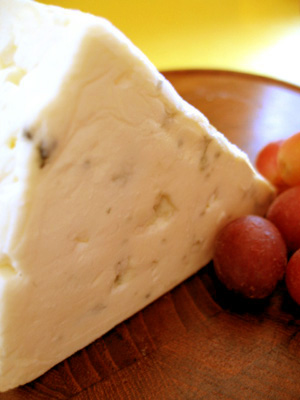 |
| Great blue cheeses of the world include Roquefort from France, Stilton from Great Britain, Gorgonzola from Italy, Cabrales from Spain and Original Blue from California.
Photo by Melody Lan. |
| WHAT IT IS: A creamy, melt-in-your-mouth farmstead blue cheese from Marin County, California. |
| WHY IT’S DIFFERENT: An exceptional-quality cheese that has full, rich blue flavor without any of the sharpness that drives some people away from blue cheeses. |
| WHY WE LOVE IT: It dazzles the palate, whether in savory company with other cheeses, nuts and olives, or as a sweet dessert with peaches, pears and a glass of Sauternes or Port. |
| PURCHASE AT: PointReyesCheese.com |
|
|
 |

We’ve Got The Blues:
Point Reyes Original Blue
CAPSULE REPORT: Recently we spent an evening at an industry event in San Francisco, surrounded by some of the best cheeses in America. It was the cheese equivalent of being at Tiffany’s, but with the cases flung open and everything there for the taking. We left only with Point Reyes Original Blue, a cheese produced not far away, in Marin County, north of San Francisco.
The widely-acclaimed Original Blue is available at most cheese shops; perhaps less widely available, but true perfection, is their Original Blue Dip & Dressing. Of course, there are more than a few great blue cheeses in the world, several created in this very country. One can’t have them all at once, but if you’re looking for blue heaven, here’s a place to start. Read the full review below.
- For reviews of more of our favorite cheeses and articles about understanding cheese, click here.
- For the table of contents of the July issue of THE NIBBLE online magazine, plus the back issues archive and our most popular articles, click here.
- All of the Top Pick Of The Week newsletters are permanently archived on TheNibble.com, in chronological order and by product category.
|
Cheese-Lover’s Reading List
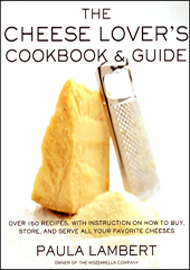 |
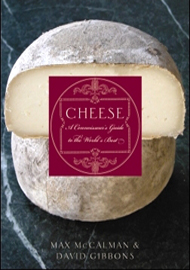 |
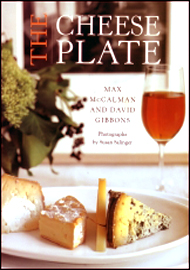 |
| The Cheese Lover’s Cookbook & Guide, by Paula Lambert. Lambert, America’s First Lady of Cheese, is founder of The Mozzarella Company: she makes great cheese as well as writes about it. This wonderful book has 150 recipes as well as detailed information on how to purchase, store and serve cheese, nutritional information, the history of cheese, and information on how to make cheese at home, beginning as Ms. Lambert did. Click here for more information or to purchase. |
Cheese: A Connoisseur’s Guide To The World’s Best, by Max McCalman and David Gibbons. Maître Fromager McCalman, who guides the country’s leading cheese restaurant, Artisanal, in New York City, profiles 200 of the world’s absolute best cheeses, including all of the practical information plus the fascinating details a cheese student covets. Winner of the 2006 James Beard Foundation Best Reference Book Award. Click here for more information or to purchase. |
The Cheese Plate, by Max McCalman and David Gibbons. If you’re interested in learning about cheese and wine, this book is a great place to start or further a cheese-at-home education. Touching all the bases, it covers cheese manufacturing methods, how to choose cheese and pair it with wine and other foods, and of course, favorite cheeses, profiles of important producers, a glossary and a list of resources. Click here for more information or to purchase. |
We’ve Got The Blues: Point Reyes Original Blue Cheese and Blue Cheese Dip
INDEX OF REVIEW
This is Page 1 of a seven-page article. Click on the black links to visit other pages.
|
MORE TO DISCOVER
|
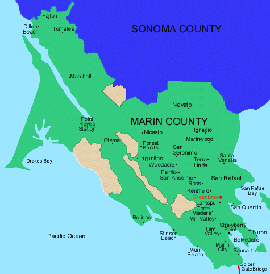 Wine lovers long to visit California’s Napa and Sonoma Valleys, but cheese lovers should consider a pilgrimage to Marin County. There, a stone’s throw from the ocean, great cheese is made by Cypress Grove Chevre, maker of one of our favorite goat cheeses, the award-winning Humboldt Fog; Cowgirl Creamery, maker of one of our favorite washed-rind cheeses (and prior NIBBLE Pick Of The Week), Red Hawk triple crème; and today’s NIBBLE, Point Reyes Farmstead* Cheese Company’s Original Blue, California’s only classic-style blue cheese. Wine lovers long to visit California’s Napa and Sonoma Valleys, but cheese lovers should consider a pilgrimage to Marin County. There, a stone’s throw from the ocean, great cheese is made by Cypress Grove Chevre, maker of one of our favorite goat cheeses, the award-winning Humboldt Fog; Cowgirl Creamery, maker of one of our favorite washed-rind cheeses (and prior NIBBLE Pick Of The Week), Red Hawk triple crème; and today’s NIBBLE, Point Reyes Farmstead* Cheese Company’s Original Blue, California’s only classic-style blue cheese.
MAP: The Golden Gate Bridge is the thin red thread at the bottom right that connects San Francisco to Marin County. Sonoma County is to the northeast, and Napa is to the east of Sonoma, not visible on this map. Tomales Bay is the long finger of water entering Marin County from the top left. At the south end of the Bay is Point Reyes, home to the Point Reyes Farmstead Cheese Company. The body of water to the left is the Pacific Ocean; at right is San Pablo Bay (below the Golden Gate Bridge, not shown, is San Francisco Bay).
*Farmstead is a term given to cheese made from milk obtained from animals milked on the farm where the cheese is produced. Handmade cheeses that are made from purchased milk are called artisanal cheeses.
Bob Giacomini, whose family began making farmstead dairy products in northern Italy more than 100 years ago, has been milking cows on his Point Reyes dairy ranch since 1959. In 2000, Bob, his wife and their four daughters founded Point Reyes Farmstead Cheese Company with a mission to produce the nation’s premier brand of high-end blue table cheese—and they made the first vat of Original Blue. Today, they still create only that one beautiful cheese plus an irresistible Original Blue Dip & Dressing.
Original Blue is a creamier style yet full-flavored blue cheese. Different than, but evocative of, a Gorgonzola dolce, it could almost melt in your mouth. It has a pronounced blue cheese character with a lovely tang, but no harshness or bite that keeps some people away from blues. It’s a luscious blue cheese that will be championed by those who love great blues, and can be approached by those who have been overwhelmed by the sharpness of other blues. People who find Roqueforts too pungent and Stiltons too strong may find blue bliss here.
Continue To Page 2: The Secrets Of Success
Go To The Article Index Above
The Secrets Of Success
Many products have a “secret recipe”: Original Blue’s is guarded by Master Cheesemaker Monte McIntyre, a relocated Iowan who has been making blue cheese for more than 15 years. The secret to Original Blue lies not only in a recipe, but in a combination of geography and other factors that produce a unique end product:
- The Grade A raw milk† comes from a closed herd of 250 Holstein cows that graze in the hilly green pastures
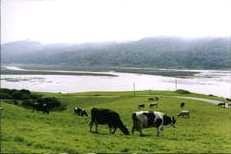 overlooking Tomales Bay, a long, narrow finger of water created by a peninsula that separates the Pacific Ocean from the mainland. Since Original Blue is a farmstead cheese, this imparts the distinct taste of “terroir”‡: the cows’ milk reflects the flavor of the terrain. Animals from the same herd moved ten miles away to graze would produce a different-flavored cheese. overlooking Tomales Bay, a long, narrow finger of water created by a peninsula that separates the Pacific Ocean from the mainland. Since Original Blue is a farmstead cheese, this imparts the distinct taste of “terroir”‡: the cows’ milk reflects the flavor of the terrain. Animals from the same herd moved ten miles away to graze would produce a different-flavored cheese.
†Raw (unpasteurized) milk retains more flavor, but by law must be aged 60 days or more to kill any harmful bacteria that might be present in the unpasteurized milk.
‡Terroir, pronounced ter-WAH, is the French word for soil, land or terrain. The term is used to convey the larger concept of “a sense of place,” its specific soil, geology, aspect, altitude and microclimate—the sum of the effects of the environment on the creation of what is grown there.
- The coastal fog and the salty Pacific breezes that drift in from the bay impact the vegetation that is eaten by the herd, as well as help cure and age the cheeses.
- Time is a human-added factor that influences the outcome: cheesemaking begins within two or three hours of milking. The cheese is made from the freshest possible milk.
The milking starts each day at 2 a.m. and then the cheesemaking begins. Starter cultures, kosher salt, Penicillium roqueforti (the mold that creates the blue veining) and rennet (the coagulating enzyme that creates curds) are then mixed into the milk. After the curds separate from the whey, the whey is drained off and the curds are “hooped” into forms to create individual 6-1/2 pound wheels. The cheese is all natural: the milk is hormone-free, contains no preservatives, bleaches or whiteners, and is made with microbial rennet.
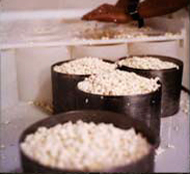 |
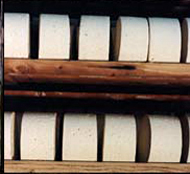 |
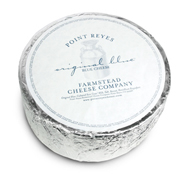 |
Fresh curds, “hooped” into forms, look like relatives of large curds of cottage cheese. They will coalesce into solid wheels. |
The 6-1/2 pound wheels age on racks for 5 to 6 months. During this long aging period the creamy texture and full flavors develop. |
Six-month-old cheese is ready for sale. |
Continue To Page 3: The Secrets Of Success
Go To The Article Index Above
Serving Suggestions
Traditional blue cheeses are crumbly by nature and it is difficult to get a clean slice with even the sharpest knife. Experts use a wire or a taut piece of dental floss to make a clean cut through the cheese. While Original Blue is creamier and therefore easier to slice cleanly, if you eat blues regularly, you may wish to purchase a wire—they’re inexpensive, and we’ve included a selection at the end of this review.
- Blue cheese is assertive so it combines well with bland foods like pasta and polenta, as well as with rich foods like beef.
- Always use good quality blue cheese when cooking: the flavors become stronger when the cheese is heated, so any sharpness or bitterness will be accentuated.
- The cheese will melt into puddles under high heat, so add it near the end of baking, or remove the pan from the heat before stirring in the cheese. Alternatively, reserve part of the cheese to sprinkle on at the end so you’ll have attractive bits of blue cheese showing.
- When serving in an uncooked dish—a sandwich, salad or cheese plate, e.g.—always have the cheese at room temperature so the complex flavors fully present themselves.
Here are just a few ways we enjoy Original Blue:
Appetizers & Hors D’Oeuvres
- With prosciutto-wrapped figs—place a piece of cheese on the fig half before you wrap it in prosciutto (you can serve them “cru” or grilled and drizzled with olive oil—grill for about 2 minutes on each side until the prosciutto starts to crisp)
- Mashed and stuffed into celery stalks—a 1950s concept that’s back in style (if you want a 21st century adaptation, stuff fennel leaves for an hors d’oeuvre or an amuse bouche)
- On crostini
Salads
- In a blue cheese dressing (there’s a fine recipe on the company website)
- Crumbled in a frisée salad with lardons and walnuts, or a sweet version with thin red pear slices and candied walnuts
- Sprinkled atop a roasted beet salad
- On a Caesar salad—prepare as usual with Parmesan and crumble some Original Blue on top for a second dimension of cheese flavor
|
 |
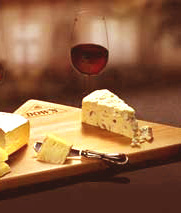
Try Original Blue with Graham’s
Six Grapes, a ruby Port from the
same vineyards as the Vintage Port.
Very full-bodied but not as heavy as
vintage, it’s a sweet, luscious wine
to enjoy for dessert with blue and
other cheeses. It’s less than $20
a bottle, and an open bottle will
keep in the refrigerator for weeks.
It’s readily available at wine stores
or at Wine.com. Dow’s LBV and
Quinta da Senhora da Ribeira are
also stunning pairings.
|
Lunch & Dinner
- On top of a burger, or in a stuffed burger
- On a pizza crust with a ricotta topping, roasted red peppers and fresh basil and rosemary
- As a grilled cheese sandwich on raisin, walnut, walnut-currant or semolina bread (first toast the bread, then top with crumbled cheese and grill until it starts to melt)
- As a garnish for any type of steak—add a small wedge to the plate (we use a large beefsteak tomato slice as the base and position the cheese on top of it with a basil leaf or two)
Plus...
- As part of a cheese plate
- For dessert with a glass of Port, Sauternes or other full-bodied dessert wine
- As a snack with some kalamata olives, nuts (we favor walnuts and almonds), fresh or dried fruits, a drizzle of lavender honey and/or some slices of crusty baguette
- To paraphrase Emily Dickinson, the Original Blue alone will do if accompaniments are few
Continue To Page 4: The Secrets Of Success
Go To The Article Index Above
Great Recipes
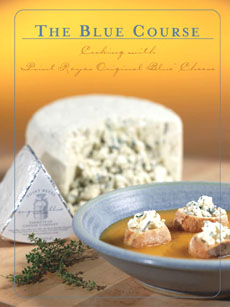 We’ve selected two wonderful recipes, below, from The Blue Course, Point Reyes Farmstead’s charming soft-cover recipe book for Original Blue. There are a few other recipes on the company website (where the book can be purchased). The book has excellent information about blue cheese, plus much more temptation among the 50 recipes in the book, including: We’ve selected two wonderful recipes, below, from The Blue Course, Point Reyes Farmstead’s charming soft-cover recipe book for Original Blue. There are a few other recipes on the company website (where the book can be purchased). The book has excellent information about blue cheese, plus much more temptation among the 50 recipes in the book, including:
- Focaccia With Caramelized Onions, Pears &
Original Blue
- Original Blue Coleslaw
- Pumpkin Soup with Original Blue Toasts
- Blue and Red Pear Risotto
- Original Blue Beef Wellington
- Fig Walnut Biscotti With Original Blue
- Blue Cheese Ice Cream
Blue lovers will want to make every one of them. To tide you over:

Point Reyes Original Blue Potato Salad
Ingredients
- 5 pounds red new potatoes
- 1/2 cup dry white wine
- 1-1/4 cups mayonnaise
- 1-1/4 cups sour cream
- 2-1/2 tablespoons Dijon mustard
- 2-1/2 tablespoons cider vinegar
- 1/2 pound Original Blue Cheese,
crumbled
- 5 green onions, minced
- 1-1/2 cups chopped celery
- Salt and freshly ground pepper,
to taste
Directions
- Place potatoes in large pot. Cover
with cold water. Boil until tender. Drain. Cool slightly.
- Peel potatoes, if desired. Cut into
1-inch pieces. Transfer to large bowl.
- Add wine, season with salt and
pepper and toss to coat. Cool. Add
all remaining ingredients, mix, and
adjust seasoning as needed.
- Let stand 30 minutes at room
temperature before serving. Can be
prepared 1 day ahead: cover and
refrigerate.
|
 |

Point Reyes Original Blue Mashed Potatoes
Ingredients
- 4 large Yukon Gold potatoes, peeled
and cubed
- 2 tablespoons (1/4 stick) butter
- 1/3 cup whole milk
- 1/3 cup chopped green onion
- 6 ounces Original Blue Cheese,
crumbled
- Salt and white pepper, to taste
Directions
- Cook potatoes in saucepan of boiling
salted water until tender, about 20
minutes.
- Drain potatoes and force through ricer
or mash with an electric mixer.
- Melt butter in small saucepan
with milk.
- Add milk mixture to potatoes and
blend. Fold in green onion and
Original Blue Cheese.
- Season with salt and pepper,
if desired. Serves 5 to 6.
|
Caring For Your Cheese
Like wine, cheese is a living, breathing food. Cheese’s moisture continues to evaporate as it ages*; the goal when storing cheese is to allow it to continue to breathe and retain its natural moisture. Most cheeses should not be wrapped directly in plastic wrap: it cuts off their ability to breathe and can alter the taste and texture. Waxed paper and parchment are the preferred wrappings. Retailers use plastic wrap because their cheeses turn over quickly, and because it is the most efficient way to display it to customers.
In general, cheeses are sold at peak “ripeness” and you should buy no more cheese than you plan to eat within a few days. However, Original Blue has staying power if you follow these directions:
- Keep the Original Blue foil in place
- Wrap the cheese in clean wax paper after each use
- Then place in a resealable heavy plastic bag to protect smells from migrating
|
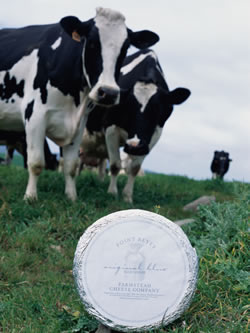 Take good care of our cheese—or else! Take good care of our cheese—or else!
|
- Store in the refrigerator’s dairy compartment (cheese likes a stable environment—each time you open the door the temperature in the front of the refrigerator and on the refrigerator door shelves changes)
|
Properly stored, Original Blue will last about six weeks in the refrigerator. Flavors may become stronger with age. As with other cheeses, any exterior mold that grows should just be scraped off—it is not harmful.
*Aged, dry cheeses, such as Parmigiano-Reggiano, have a much longer shelf life since most of the moisture has evaporated.
Take A Dip: Original Blue Dip & Dressing
What happens when you take all that Original Blue goodness and turn it into a chunky blue cheese dip? You get a dip that blue cheese lovers will flip over, and even people who don’t like blue cheese may enjoy it (the non-blue lovers at our tasting were converted instantly).
The company’s second product, Original BlueDip and Dressing, has been selling exclusively at the Saturday San Francisco Ferry Plaza Farmers Market for the past two years (where we first discovered it). It is now available at specialty food stores nationwide, in 7-ounce containers. They say good things come in small packages. We can only advise: don’t buy just one, even on your first trial. Any true blue lover could happily eat one container as a first course.
The dip is loaded with large chunks of Original Blue. Whatever you like to dip—crudités, potato chips, pretzels, crackers, bread sticks or chicken wings—your experience will be significantly enhanced. Some of our favorite uses include:
- Instant Hors D’Oeuvre. Arrange endive leaves on tray. Add dip to the middle of the leaves. If you have time, add some color, like snipped chives or dots of roasted red pepper.
- Blue BLT. Hold the mayo and put the dip on a BLT. It’s a big improvement over the original.
|
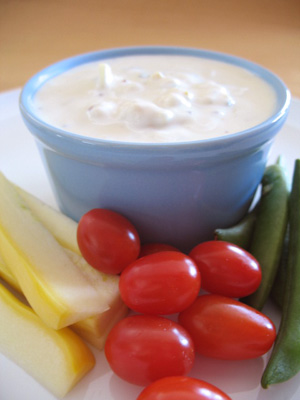 Crudités with Original Blue Dip & Dressing is a satisfying summer lunch. Photo by Melody Lan.
Crudités with Original Blue Dip & Dressing is a satisfying summer lunch. Photo by Melody Lan. |
- Blueburger. Better than trying to melt cheese on a burger, here’s the cheese and the condiment in one. There’s no need to add anything else: this is a dazzling dressing.
|
The cheeses aren’t blue, of course—they’re dotted with dark blue and blue-green veins. The veins are Penicillium molds—cousins of the antibiotic. The molds are also relatives of the bloomy mold that covers Bries and Camemberts. Blue cheeses were originally a natural product of their environment. For example, the caves of Roquefort sur Soulzon in southwest France are teeming with Penicillium roqueforti (the town gave its name to the cheese and the mold).
- In the absence of natural caves, mold spores are injected into blue cheese to ripen it: Danish Blue is ripened by Penicillium roqueforti, Gorgonzola by Penicillium gorgonzola, Roquefort by Penicillium roqueforti and Stilton by Penicillium glaucum. In addition to the blue veins, the molds provide a distinct flavor profile to the cheese, which ranges from fairly mild to assertive and pungent.
- Some blue-veined cheeses can be found in the other categories—blue goat cheeses and double- and triple-crémes (Brie-types), for example. It’s possible to produce a blue in almost every cheese category except for fresh cheeses.
- The Penicillium mold will not grow properly until oxygen comes into contact with it, so the cheeses are pierced with pins—a process called “punching” or “needling.” Air is also injected, which causes the cheeses to develop a very high acid content and crumb-like texture.
- Blues can range from high moisture and creamy to firm and well-aged. The longer cheeses are aged, the more solid they become.
- Blues are a particularly complex type of cheese to produce. It’s easy for the levels of both salt and mold in a blue cheese to go haywire. Even planned mold growth inside a blue causes radical change in the pH of the product, as well as alterations in the fats and proteins.
- The most venerable and famous blues—English Stilton, French Roquefort, Italian Gorgonzola and Spanish Cabrales—are D.O.P. or A.O.C. protected. But there are dozens and dozens of prominent blues, including Bleu de Bresse and Bleu d’Auvergne (France), Danablu (Denmark), Blue Cheshire (England), and a good number produced in the United States, from the venerable Maytag and those mentioned below, plus numerous others.
Port, sparkling wine and zinfandel pair well with blue cheeses, as do barleywine-style ale, Belgian ale, Trappist beer and stout. Read more about blue cheese in “In Praise of the Blues” by Stephanie Zonis, THE NIBBLE’s cheese columnist.
Other Great American Blues
We could have written about a dozen other great American blues...and in the future, we will. Until then, here are some that should be tried sooner rather than later.
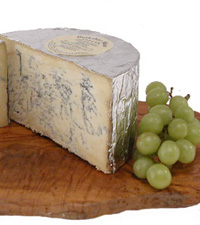 Berkshire Blue. A raw milk artisan cheese made from Jersey cow’s milk in small batches, Berkshire Blue is made in Massachusetts by Michael Miller. This beautiful blue licenses the recipe of the famous blue made by the Willett Farm Dairy of Somerset, England. The main difference is that the U.S. version is aged an extra 15 days at 35ºF; by law, raw milk cheeses cannot be released before 60 days. This artisan cheese is made completely by hand, and by only one person. It is hand-stirred, hand-ladled and manually turned, resulting in an exceptionally creamy, smooth blue. ($17.99/pound) Berkshire Blue. A raw milk artisan cheese made from Jersey cow’s milk in small batches, Berkshire Blue is made in Massachusetts by Michael Miller. This beautiful blue licenses the recipe of the famous blue made by the Willett Farm Dairy of Somerset, England. The main difference is that the U.S. version is aged an extra 15 days at 35ºF; by law, raw milk cheeses cannot be released before 60 days. This artisan cheese is made completely by hand, and by only one person. It is hand-stirred, hand-ladled and manually turned, resulting in an exceptionally creamy, smooth blue. ($17.99/pound)
Deep Ellum Blue. Made by Paula Lambert of The Mozzarella Company, this cheese is named for the Dallas neighborhood where the factory is 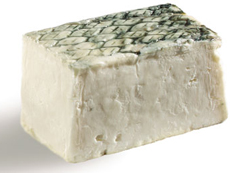 located, an area that in the past was home to legendary blues singers. Every cheese made by The Mozzarella Company is fascinatingly different in its category. Deep Ellum Blue is a creamy, spreadable blue, aged for at least two months and bathed with extra-virgin olive oil. It has no actual rind, only a diamond-scored, blue-mold-mottled exterior. The cheese is subtly flavored, not too strong and not too salty, with a robust and earthy flavor. It is delicious atop chicken, beef and veal dishes; and as with all blues, in salads and with Port and dessert wines. Read our full review of Mozzarella Company, ($15.25/pound) located, an area that in the past was home to legendary blues singers. Every cheese made by The Mozzarella Company is fascinatingly different in its category. Deep Ellum Blue is a creamy, spreadable blue, aged for at least two months and bathed with extra-virgin olive oil. It has no actual rind, only a diamond-scored, blue-mold-mottled exterior. The cheese is subtly flavored, not too strong and not too salty, with a robust and earthy flavor. It is delicious atop chicken, beef and veal dishes; and as with all blues, in salads and with Port and dessert wines. Read our full review of Mozzarella Company, ($15.25/pound)
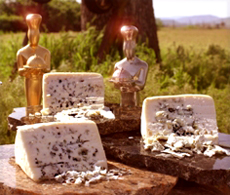 Rogue Creamery Blues. We’ve previously written about Rogue Creamery’s Smokey Blue, which made history in 2003 at the World Cheese Awards in London when it won the coveted Overall Best Blue Cheese, beating out entries from all over Europe. It’s part of a family of blues you could marry into—it won Best Overall Product Line, in any category, at this year’s Fancy Food Show. We say: meet the whole family! Invite all the Rogues over—Crater Lake Blue, Echo Mountain, Oregon Blue Vein, Oregonzola, Rogue River Blue and Smokey Blue—and have a tasting spanning different degrees of sharpness and texture. “Dad” is cheesemaker David Gremmels. (3-Blue Sampler, $25.60) Rogue Creamery Blues. We’ve previously written about Rogue Creamery’s Smokey Blue, which made history in 2003 at the World Cheese Awards in London when it won the coveted Overall Best Blue Cheese, beating out entries from all over Europe. It’s part of a family of blues you could marry into—it won Best Overall Product Line, in any category, at this year’s Fancy Food Show. We say: meet the whole family! Invite all the Rogues over—Crater Lake Blue, Echo Mountain, Oregon Blue Vein, Oregonzola, Rogue River Blue and Smokey Blue—and have a tasting spanning different degrees of sharpness and texture. “Dad” is cheesemaker David Gremmels. (3-Blue Sampler, $25.60)
|
We could never be blue, surrounded by such wonderful blues.
—Karen Hochman
Updated January 25, 2007
FORWARD THIS NIBBLE to anyone who loves cheese (which is almost everyone we know).
POinT REYES Farmstead Cheese COMPANY
Original Blue Cheese and Original Blue Dip
& Dressing
Certified kosher by Orthodox Rabbinical Council
of South Florida
- Three 6-Ounces Wedges
$38.00
- Half Wheel (About 3 Pounds)
$58.00
- Whole Wheel (About 6.5 Pounds)
$100
- Point Reyes Original Blue Dip & Dressing
Two 7-Ounce Tubs
$10.00
- “The Blue Course” Cookbook
$10.00
- Gift Packs
Wedges With Other Foods
$43.00 to $46.00
To purchase online, visit
PointReyesCheese.com
or telephone 1.800.591.6878.
Point Reyes cheeses are available at specialty food stores including online stores, and at cheese shops nationwide, where smaller amounts can be purchased.
Prices and product availability are verified at publication but are subject to change.
|
 |
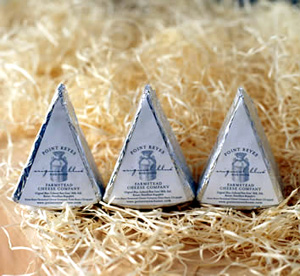
Above, 6-ounce wedges. Below, splendor in the grass (or at
least, in the hay): a full wheel, about 6.5 pounds of creamy
blue.
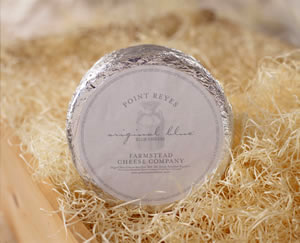
|
More Favorite Cheese Books
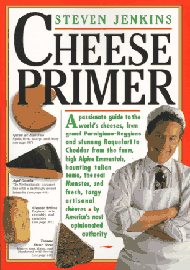 |
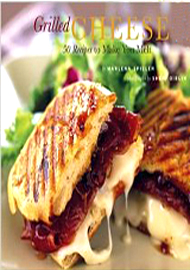 |
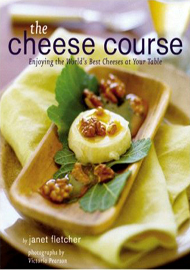 |
| The Cheese Primer, by Steve Jenkins (paperback). For 20 years, Steve Jenkins has led the way in upgrading the quality of cheese sold at fine food stores in the U.S. In this volume, he shares his encyclopedic knowledge. Jenkins tells all about cheesemaking at the commercial as well as the artistic level. The guide to pronunciation is particularly helpful. Passionately written, a must for every shelf. Click here for more information or to purchase. |
Grilled Cheese: 50 Recipes To Make You Melt, by Marlena Spieler (paperback). This is not your mother’s grilled cheese: fresh mozzarella and salty prosciutto are spread with sweet fig jam and enclosed within crisply toasted bread, roasted red pepper, sweet onion and paprika on a standard tuna melt, and goat cheese croutons for salads are just the beginning. Click here for more information or to purchase. |
The Cheese Course, by Janet Fletcher. It’s more than 4 hunks of cheese on a wooden board: learn how to prepare stunning and imaginative cheese courses that can be the highlight of an otherwise simple meal. The good news is, it’s relatively simple to do it—you don’t even have to know how to cook! This book is also a great gift for anyone who loves to entertain. Click here for more information or to purchase. |
FOR ADDITIONAL INFORMATION, special offers,
contests, opinion surveys, THE NIBBLE
back issues archive, product gift-finder, links to our favorite
food websites, and the ability to nominate YOUR favorite nibbles,
visit the home page of TheNibble.com.
Do you have friends who would enjoy THE NIBBLE?
Click here to send them an invitation to sign up for their own copy. |
ABOUT THE NIBBLE. THE NIBBLE™, Great Food Finds™, is an online magazine about specialty foods and the gourmet life. It is the only consumer publication and website that focuses on reviewing the best specialty foods and beverages, in every category. The magazine also covers tabletop items, gourmet housewares, and other areas of interest to people who love fine food.
© Copyright 2004-2026 Lifestyle Direct, Inc. All rights
reserved. All information contained herein is subject to change at any time
without notice. All details must be directly confirmed with manufacturers, service
establishments and other third parties. The material in this newsletter may not
be reproduced, distributed, transmitted, cached, or otherwise used, except with
the prior written permission of Lifestyle Direct, Inc.
|
 |
|
 |







 Wine lovers long to visit California’s Napa and Sonoma Valleys, but cheese lovers should consider a pilgrimage to Marin County. There, a stone’s throw from the ocean, great cheese is made by Cypress Grove Chevre, maker of one of our favorite goat cheeses, the award-winning Humboldt Fog; Cowgirl Creamery, maker of one of our favorite washed-rind cheeses (and prior NIBBLE Pick Of The Week),
Wine lovers long to visit California’s Napa and Sonoma Valleys, but cheese lovers should consider a pilgrimage to Marin County. There, a stone’s throw from the ocean, great cheese is made by Cypress Grove Chevre, maker of one of our favorite goat cheeses, the award-winning Humboldt Fog; Cowgirl Creamery, maker of one of our favorite washed-rind cheeses (and prior NIBBLE Pick Of The Week),  overlooking Tomales Bay, a long, narrow finger of water created by a peninsula that separates the Pacific Ocean from the mainland. Since Original Blue is a farmstead cheese, this imparts the distinct taste of “terroir”‡: the cows’ milk reflects the flavor of the terrain. Animals from the same herd moved ten miles away to graze would produce a different-flavored cheese.
overlooking Tomales Bay, a long, narrow finger of water created by a peninsula that separates the Pacific Ocean from the mainland. Since Original Blue is a farmstead cheese, this imparts the distinct taste of “terroir”‡: the cows’ milk reflects the flavor of the terrain. Animals from the same herd moved ten miles away to graze would produce a different-flavored cheese.



 We’ve selected two wonderful recipes, below, from The Blue Course, Point Reyes Farmstead’s charming soft-cover recipe book for Original Blue. There are a few other recipes on the company
We’ve selected two wonderful recipes, below, from The Blue Course, Point Reyes Farmstead’s charming soft-cover recipe book for Original Blue. There are a few other recipes on the company  Take good care of our cheese—or else!
Take good care of our cheese—or else!
 Berkshire Blue
Berkshire Blue located, an area that in the past was home to legendary blues singers. Every cheese made by The Mozzarella Company is fascinatingly different in its category. Deep Ellum Blue is a creamy, spreadable blue, aged for at least two months and bathed with extra-virgin olive oil. It has no actual rind, only a diamond-scored, blue-mold-mottled exterior. The cheese is subtly flavored, not too strong and not too salty, with a robust and earthy flavor. It is delicious atop chicken, beef and veal dishes; and as with all blues, in salads and with Port and dessert wines. Read our full review of
located, an area that in the past was home to legendary blues singers. Every cheese made by The Mozzarella Company is fascinatingly different in its category. Deep Ellum Blue is a creamy, spreadable blue, aged for at least two months and bathed with extra-virgin olive oil. It has no actual rind, only a diamond-scored, blue-mold-mottled exterior. The cheese is subtly flavored, not too strong and not too salty, with a robust and earthy flavor. It is delicious atop chicken, beef and veal dishes; and as with all blues, in salads and with Port and dessert wines. Read our full review of  Rogue Creamery Blues
Rogue Creamery Blues



